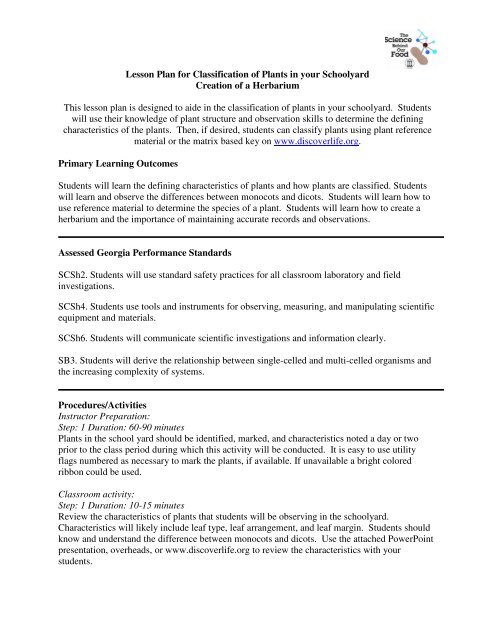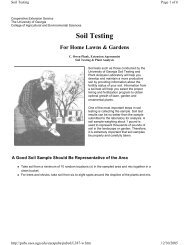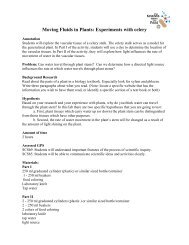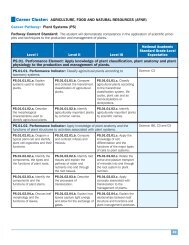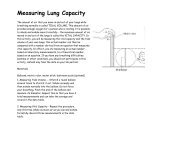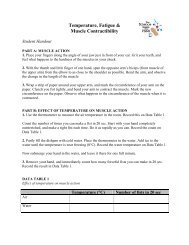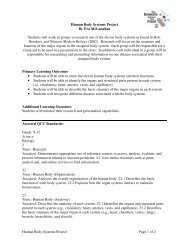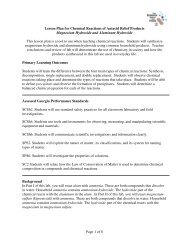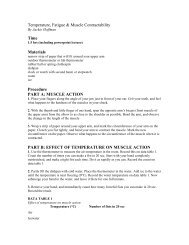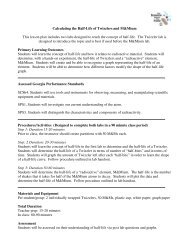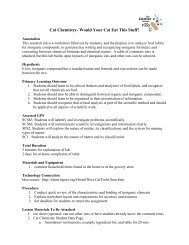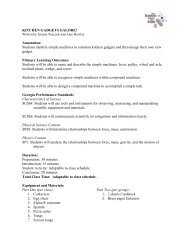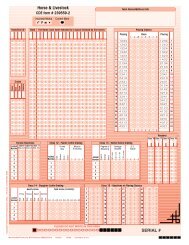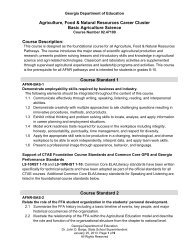Lesson Plan for Classification of Plants in your Schoolyard Creation ...
Lesson Plan for Classification of Plants in your Schoolyard Creation ...
Lesson Plan for Classification of Plants in your Schoolyard Creation ...
Create successful ePaper yourself
Turn your PDF publications into a flip-book with our unique Google optimized e-Paper software.
<strong>Lesson</strong> <strong>Plan</strong> <strong>for</strong> <strong>Classification</strong> <strong>of</strong> <strong>Plan</strong>ts <strong>in</strong> <strong>your</strong> <strong>Schoolyard</strong><br />
<strong>Creation</strong> <strong>of</strong> a Herbarium<br />
This lesson plan is designed to aide <strong>in</strong> the classification <strong>of</strong> plants <strong>in</strong> <strong>your</strong> schoolyard. Students<br />
will use their knowledge <strong>of</strong> plant structure and observation skills to determ<strong>in</strong>e the def<strong>in</strong><strong>in</strong>g<br />
characteristics <strong>of</strong> the plants. Then, if desired, students can classify plants us<strong>in</strong>g plant reference<br />
material or the matrix based key on www.discoverlife.org.<br />
Primary Learn<strong>in</strong>g Outcomes<br />
Students will learn the def<strong>in</strong><strong>in</strong>g characteristics <strong>of</strong> plants and how plants are classified. Students<br />
will learn and observe the differences between monocots and dicots. Students will learn how to<br />
use reference material to determ<strong>in</strong>e the species <strong>of</strong> a plant. Students will learn how to create a<br />
herbarium and the importance <strong>of</strong> ma<strong>in</strong>ta<strong>in</strong><strong>in</strong>g accurate records and observations.<br />
Assessed Georgia Per<strong>for</strong>mance Standards<br />
SCSh2. Students will use standard safety practices <strong>for</strong> all classroom laboratory and field<br />
<strong>in</strong>vestigations.<br />
SCSh4. Students use tools and <strong>in</strong>struments <strong>for</strong> observ<strong>in</strong>g, measur<strong>in</strong>g, and manipulat<strong>in</strong>g scientific<br />
equipment and materials.<br />
SCSh6. Students will communicate scientific <strong>in</strong>vestigations and <strong>in</strong><strong>for</strong>mation clearly.<br />
SB3. Students will derive the relationship between s<strong>in</strong>gle-celled and multi-celled organisms and<br />
the <strong>in</strong>creas<strong>in</strong>g complexity <strong>of</strong> systems.<br />
Procedures/Activities<br />
Instructor Preparation:<br />
Step: 1 Duration: 60-90 m<strong>in</strong>utes<br />
<strong>Plan</strong>ts <strong>in</strong> the school yard should be identified, marked, and characteristics noted a day or two<br />
prior to the class period dur<strong>in</strong>g which this activity will be conducted. It is easy to use utility<br />
flags numbered as necessary to mark the plants, if available. If unavailable a bright colored<br />
ribbon could be used.<br />
Classroom activity:<br />
Step: 1 Duration: 10-15 m<strong>in</strong>utes<br />
Review the characteristics <strong>of</strong> plants that students will be observ<strong>in</strong>g <strong>in</strong> the schoolyard.<br />
Characteristics will likely <strong>in</strong>clude leaf type, leaf arrangement, and leaf marg<strong>in</strong>. Students should<br />
know and understand the difference between monocots and dicots. Use the attached PowerPo<strong>in</strong>t<br />
presentation, overheads, or www.discoverlife.org to review the characteristics with <strong>your</strong><br />
students.
Step: 2 Duration: 60-70 m<strong>in</strong>utes<br />
Equipped with a clipboard, pencil, and characteristics chart (see Field Chart 1 at end <strong>of</strong><br />
document), students should observe the plants and fill <strong>in</strong> the plant characteristics chart <strong>for</strong> each<br />
plant marked. If desired, dur<strong>in</strong>g this time plant clipp<strong>in</strong>gs may be obta<strong>in</strong>ed to create a herbarium<br />
<strong>for</strong> the class. If students work <strong>in</strong> groups, each group may be assigned several plants to collect<br />
clipp<strong>in</strong>gs with the assistance <strong>of</strong> the teacher and a pair <strong>of</strong> garden<strong>in</strong>g sheers. Also, pictures <strong>of</strong> the<br />
plants may be taken if a camera is readily available—this would further aid <strong>in</strong> classification.<br />
Step: 3 Duration: 30-45 m<strong>in</strong>utes (This activity is best done by the teacher outside <strong>of</strong> class)<br />
Creat<strong>in</strong>g the herbarium is easy. The leaves need to be pressed <strong>for</strong> at least 24 hours between<br />
sheets <strong>of</strong> newspaper under a set <strong>of</strong> heavy books prior to this step. After leaves are pressed, place<br />
them between two sheets <strong>of</strong> wax paper (waxed sides <strong>in</strong> toward the leaf). Gently press the wax<br />
paper with a medium hot iron slowly over the entire surface <strong>for</strong> about 10 seconds. Repeat <strong>for</strong> the<br />
rema<strong>in</strong><strong>in</strong>g leaves you wish to press. The wax paper will be hot after press<strong>in</strong>g, so allow the<br />
pressed leaves to cool be<strong>for</strong>e us<strong>in</strong>g. After step 4 is completed, the herbarium should have labels<br />
applied to the plant specimens <strong>for</strong> preservation and future reference.<br />
Step: 4 Duration: 60-70 m<strong>in</strong>utes<br />
<strong>Classification</strong> <strong>of</strong> the plants us<strong>in</strong>g either reference material available at the school or local library,<br />
or us<strong>in</strong>g the web-based matrix key at www.discoverlife.org. Once the plants are classified, the<br />
labels should be applied to the herbarium specimens. Labels should <strong>in</strong>clude <strong>in</strong><strong>for</strong>mation such as<br />
scientific name, common name, date collected, where collected, and who collected.<br />
Materials and Equipment<br />
<strong>Plan</strong>t characteristics: Clipboard, field markers (flags or bright ribbon)<br />
Herbarium: waxed paper, iron, newspapers, heavy books, labels<br />
Total Duration<br />
Teacher preparation: 60-90 m<strong>in</strong>utes <strong>for</strong> plant characteristics, 30-45 m<strong>in</strong>utes <strong>for</strong> herbarium<br />
creation<br />
Two class periods will be necessary to classify the plants: The first to observe and determ<strong>in</strong>e<br />
characteristics; the second to classify and determ<strong>in</strong>e the species <strong>of</strong> the plants.<br />
Assessment<br />
Students will be assessed accord<strong>in</strong>g to the accurate completion <strong>of</strong> their field sheet and the<br />
identification <strong>of</strong> the species.<br />
Modifications<br />
The herbarium may be created by students by secur<strong>in</strong>g the leaves to pieces <strong>of</strong> white paper with<br />
tape or glue. The <strong>in</strong><strong>for</strong>mation about the specimen can then be directly written on the paper. As<br />
much or as little <strong>of</strong> this lesson can be used as desired by the <strong>in</strong>structor. There are two student<br />
handouts attached at the end <strong>of</strong> the lesson plan (Field Chart 1 and Field Chart 2). The <strong>in</strong>structor<br />
may choose to use the Field Chart 2 if there is no desire to create a herbarium, but rather just<br />
learn plant characteristics.
Field Chart 1<br />
Name ____________________<br />
<strong>Plan</strong>t Number<br />
Group Leaf Type Leaf Arrangement Leaf Marg<strong>in</strong> Other Notes <strong>Plan</strong>t Species<br />
(Grassy or Woody) (Simple or Compound) (opposite, alternate, whorled) (Hairy, Lobed, Smooth, Toothed, Wavy) (i.e. bark texture/color, flower, fruit) (Determ<strong>in</strong>ed us<strong>in</strong>g DiscoverLife.org)<br />
1<br />
2<br />
3<br />
4<br />
5<br />
6<br />
7<br />
8<br />
9
Field Chart 1<br />
Name ____________________<br />
<strong>Plan</strong>t Number<br />
Group Leaf Type Leaf Arrangement Leaf Marg<strong>in</strong> Other Notes <strong>Plan</strong>t Species<br />
(Grassy or Woody) (Simple or Compound) (opposite, alternate, whorled) (Hairy, Lobed, Smooth, Toothed, Wavy) (i.e. bark texture/color, flower, fruit) (Determ<strong>in</strong>ed us<strong>in</strong>g DiscoverLife.org)<br />
10<br />
11<br />
12<br />
13<br />
14<br />
15<br />
16<br />
17<br />
18
<strong>Plan</strong>t Number<br />
Field Chart 2<br />
Type Leaf Type Leaf Arrangement<br />
(Monocot or Dicot) (Simple or Compound) (opposite, alternate, whorled)<br />
Sketch<br />
Name ____________________<br />
1<br />
2<br />
3<br />
4<br />
5<br />
6<br />
7
<strong>Plan</strong>t Number<br />
Field Chart 2<br />
Type Leaf Type Leaf Arrangement<br />
(Monocot or Dicot) (Simple or Compound) (opposite, alternate, whorled)<br />
Sketch<br />
Name ____________________<br />
8<br />
9<br />
10<br />
11<br />
12<br />
13<br />
14
Characteristics <strong>of</strong> Leaves and<br />
Leaf Structures<br />
Eva McLanahan<br />
Function <strong>of</strong> Leaves<br />
• Manufacture food <strong>for</strong> the plant through the<br />
process <strong>of</strong> photosynthesis<br />
• Equation <strong>for</strong> Photosynthesis:<br />
– CO 2 + H 2 O C 6 H 12 O 6 + O 2<br />
1
• Look at leaf venation<br />
Monocot vs Dicot<br />
Monocots<br />
Parallel-ve<strong>in</strong>ed leaves<br />
Dicots<br />
Net-ve<strong>in</strong>ed leaves<br />
Dicots<br />
Leaf Structure<br />
Simple<br />
Compound<br />
2
Dicots<br />
Leaf Arrangements<br />
Alternate<br />
Whorled<br />
Opposite<br />
Monocot Dicot<br />
Dicot<br />
Monocot<br />
3
Simple Compound<br />
Simple<br />
Compound<br />
Alternate Opposite Whorled<br />
A B C<br />
Opposite<br />
Whorled<br />
Alternate<br />
4
Dicots<br />
Leaf Marg<strong>in</strong>s<br />
Marg<strong>in</strong>: Edge – as <strong>in</strong> the edge <strong>of</strong> a leaf or edge <strong>of</strong> a lake.<br />
Hairy Lobed Smooth Toothed Wavy<br />
5


